Did Safe Cycling Infrastructure Still Matter During a COVID-19 Lockdown?
Abstract
1. Introduction
2. Literature Review
3. Data and Analytical Model
3.1. Case Study City
3.2. Data
3.3. Analytical Method
4. Results
5. Conclusions
Author Contributions
Funding
Acknowledgments
Conflicts of Interest
Appendix
| Nothing | Calmed/Low | Demarcation | Leisure (1,0,1) | Park (0,0,3) | Segregate | Shared off | Signed (1,0,1) | |
|---|---|---|---|---|---|---|---|---|
| Estimate | Estimate | Estimate | Estimate | Estimate | Estimate | Estimate | Estimate | |
| Constant | 0.022 *** | 0.019 *** | 0.077 *** | 0.098 *** | 0.033 *** | 0.065 *** | ||
| Government interventions | ||||||||
| Work from home | 0.012 *** | 0.012 *** | 0.051 *** | 0.028 | 0.043 *** | 0.006 | 0.079 *** | 0.008 |
| Lockdown | 0.014 *** | 0.010 ** | 0.051 *** | −0.009 | 0.047 *** | −0.011 * | 0.071 *** | 0.006 |
| Day of week (ref:Sunday) | ||||||||
| Monday | −0.012 *** | 0.000 | −0.037 *** | −0.082 *** | −0.020 *** | 0.007 * | −0.033 *** | −0.015 ** |
| Tuesday | −0.008 *** | 0.006 ** | −0.034 *** | −0.074 *** | −0.005 | 0.011 *** | −0.019 *** | −0.004 |
| Wednesday | −0.012 *** | −0.001 | −0.036 *** | −0.067 *** | −0.015 *** | 0.007 * | −0.033 *** | −0.012 * |
| Thursday | −0.009 *** | 0.003 | −0.031 *** | −0.062 *** | −0.008 ** | 0.018 *** | −0.025 *** | −0.013 * |
| Friday | −0.012 *** | 0.004 | −0.043 *** | −0.075 *** | −0.004 | 0.005 | −0.017 *** | −0.021 *** |
| Saturday | −0.005 *** | −0.002 | −0.019 *** | −0.020 * | 0.001 | −0.002 | 0.005 | −0.024 *** |
| Weather conditions | ||||||||
| Max temperature | 0.001 *** | 0.001 *** | 0.004 *** | 0.003 ** | 0.002 *** | 0.002 *** | 0.004 *** | 0.002 *** |
| Precipitation | −0.001 *** | −0.001 *** | −0.002 *** | −0.001 *** | −0.001 *** | −0.001 *** | −0.002 *** | −0.001 *** |
| Mean wind | −0.001 *** | −0.001 ** | −0.002 ** | −0.001 | −0.002 *** | −0.001 | −0.004 *** | −0.002 |
| Daylight hours | 0.000 | 0.001 | −0.001 | −0.003 | 0.002 ** | 0.002 *** | 0.003 *** | 0.004 *** |
| ar1 | 0.708 | 0.984 *** | ||||||
| ma1 | −0.663 | 0.031 | −0.906 *** | |||||
| ma2 | 0.213 *** | |||||||
| ma3 | 0.223 *** | |||||||
| Sigma | 0 | 0 | 0.001 | 0.002 | 0 | 0 | 0.001 | 0.001 |
| Likelihoood | 923.95 | 757.86 | 581.05 | 397.63 | 646.51 | 665 | 537.84 | 519.53 |
References
- European Centre for Disease Prevention and Control COVID-19 Situation Update for the EU/EEA and the UK, as of 19 June 2020. Available online: https://www.ecdc.europa.eu/en/cases-2019-ncov-eueea (accessed on 19 June 2020).
- HM Government, Our Plan to Rebuild: The UK Government’s COVID-19 Recovery Strategy. 2020. Available online: https://www.gov.uk/government/publications/our-plan-to-rebuild-the-uk-governments-covid-19-recovery-strategy (accessed on 19 July 2020).
- Sandor, A. Cycling is Booming during Coronavirus—Let’s Keep it that Way. The Independent. 2020. Available online: https://www.independent.co.uk/voices/coronavirus-uk-cycling-new-york-wuhan-pollution-driving-a9484976.html (accessed on 22 July 2020).
- Johan de Hartog, J.; Boogaard, H.; Nijland, H.; Hoek, G. Do the health benefits of cycling outweigh the risks? Environ. Health Perspect 2010, 118, 1109–1116. [Google Scholar] [CrossRef]
- Oja, P.; Titze, S.; Bauman, A.; de Geus, B.; Krenn, P.; Reger-Nash, B.; Kohlberger, T. Health benefits of cycling: A systematic review. Scand. J. Med. Sci. Sports 2011, 21, 496–509. [Google Scholar] [CrossRef] [PubMed]
- Swiers, R.; Pritchard, C.; Gee, I. A cross sectional survey of attitudes, behaviours, barriers and motivators to cycling in University students. J. Transp. Health 2017, 6, 379–385. [Google Scholar] [CrossRef]
- Manaugh, K.; Boisjoly, G.; El-Geneidy, A. Overcoming barriers to cycling: Understanding frequency of cycling in a University setting and the factors preventing commuters from cycling on a regular basis. Transportation 2017, 44, 871–884. [Google Scholar] [CrossRef]
- Garrington, D. Halt Destruction of Nature or Suffer Even Worse Pandemics, Say World’s Top Scientists. The Guardian. Available online: https://www.theguardian.com/world/2020/apr/27/halt-destruction-nature-worse-pandemics-top-scientists (accessed on 27 April 2020).
- Celis-Morales, C.A.; Lyall, D.M.; Welsh, P.; Anderson, J.; Steell, L.; Guo, Y.; Maldonado, R.; Mackay, D.F.; Pell, J.P.; Sattar, N.; et al. Association between active commuting and incident cardiovascular disease, cancer, and mortality: Prospective cohort study. BMJ 2017, 357, j1456. [Google Scholar] [CrossRef] [PubMed]
- Gao, J.; Helbich, M.; Dijst, M.; Kamphuis, C.B.M. Socioeconomic and demographic differences in walking and cycling in the Netherlands: How do these translate into differences in health benefits? J. Transp. Health 2017, 6, 358–365. [Google Scholar] [CrossRef]
- Mulley, C.; Tyson, R.; McCue, P.; Rissel, C.; Munro, C. Valuing active travel: Including the health benefits of sustainable transport in transportation appraisal frameworks. Res. Transp. Bus. Manag. 2013, 7, 27–34. [Google Scholar] [CrossRef]
- Lee, K.; Sener, I.N. Understanding Potential Exposure of Bicyclists on Roadways to Traffic-Related Air Pollution: Findings from El Paso, Texas, Using Strava Metro Data. Int J. Environ. Res. Public Health 2019, 16, 371. [Google Scholar] [CrossRef]
- Schepers, J.P.; Heinen, E. How does a modal shift from short car trips to cycling affect road safety? Accid. Anal. Prev. 2013, 50, 1118–1127. [Google Scholar] [CrossRef]
- Welsh, C.; Celis-Morales, C.A.; Ho, F.; Lyall, D.M.; Mackay, D.; Ferguson, L.; Sattar, N.; Gray, S.R.; Gill, J.M.R.; Pell, J.P.; et al. Association of injury related hospital admissions with commuting by bicycle in the UK: Prospective population based study. BMJ 2020, 368, m336. [Google Scholar] [CrossRef]
- Tainio, M.; de Nazelle, A.J.; Götschi, T.; Kahlmeier, S.; Rojas-Rueda, D.; Nieuwenhuijsen, M.J.; de Sá, T.H.; Kelly, P.; Woodcock, J. Can air pollution negate the health benefits of cycling and walking? Prev. Med. 2016, 87, 233–236. [Google Scholar] [CrossRef]
- Christie, N.; Kimberlee, R.; Towner, E.; Rodgers, S.; Ward, H.; Sleney, J.; Lyons, R. Children aged 9–14 living in disadvantaged areas in England: Opportunities and barriers for cycling. J. Transp. Geogr. 2011, 19, 943–949. [Google Scholar] [CrossRef]
- Salmon, J.; Salmon, L.; Crawford, D.A.; Hume, C.; Timperio, A. Associations among Individual, Social, and Environmental Barriers and Children’s Walking or Cycling to School. Am. J. Health Promot. 2007, 22, 107–113. [Google Scholar] [CrossRef] [PubMed]
- Hull, A.; O’Holleran, C. Bicycle infrastructure: Can good design encourage cycling? Urban. Plan. Transp. Res. 2014, 2, 369–406. [Google Scholar] [CrossRef]
- Lawson, A.R.; Pakrashi, V.; Ghosh, B.; Szeto, W.Y. Perception of safety of cyclists in Dublin City. Accid. Anal. Prev. 2013, 50, 499–511. [Google Scholar] [CrossRef] [PubMed]
- Leden, L.; Gårder, P.; Pulkkinen, U. An expert judgment model applied to estimating the safety effect of a bicycle facility. Accid. Anal. Prev. 2000, 32, 589–599. [Google Scholar] [CrossRef]
- Thomas, B.; DeRobertis, M. The safety of urban cycle tracks: A review of the literature. Accid. Anal. Prev. 2013, 52, 219–227. [Google Scholar] [CrossRef] [PubMed]
- Winters, M.; Brauer, M.; Setton, E.M.; Teschke, K. Built Environment Influences on Healthy Transportation Choices: Bicycling versus Driving. J. Urban. Health 2010, 87, 969–993. [Google Scholar] [CrossRef]
- Goodman, A.; Panter, J.; Sharp, S.J.; Ogilvie, D. Effectiveness and equity impacts of town-wide cycling initiatives in England: A longitudinal, controlled natural experimental study. Soc. Sci. Med. 2013, 97, 228–237. [Google Scholar] [CrossRef]
- Norwood, P.; Eberth, B.; Farrar, S.; Anable, J.; Ludbrook, A. Active travel intervention and physical activity behaviour: An evaluation. Soc. Sci. Med. 2014, 113, 50–58. [Google Scholar] [CrossRef]
- Broach, J.; Dill, J.; Gliebe, J. Where do cyclists ride? A route choice model developed with revealed preference GPS data. Transp. Res. Part A Policy Pract. 2012, 46, 1730–1740. [Google Scholar] [CrossRef]
- Caulfield, B. Re-cycling a city—Examining the growth of cycling in Dublin. Transp. Res. Policy Pract. 2014, 61, 216–226. [Google Scholar] [CrossRef]
- Caulfield, B.; Brick, E.; McCarthy, O.T. Determining bicycle infrastructure preferences—A case study of Dublin. Transp. Res. Part D Transp. Environ. 2012, 17, 413–417. [Google Scholar] [CrossRef]
- Dill, J.; Gliebe, J. Understanding and Measuring Bicycling Behavior: A Focus on Travel Time and Route Choice. In Understanding and Measuring Bicycling Behavior: A Focus on Travel Time and Route Choice; Portland State University Library: Portland, OR, USA, 2008. [Google Scholar]
- Fraser, S.D.S.; Lock, K. Cycling for transport and public health: A systematic review of the effect of the environment on cycling. Eur. J. Public Health 2010, 21, 738–743. [Google Scholar] [CrossRef]
- Hankey, S.; Lindsey, G.; Wang, X.; Borah, J.; Hoff, K.; Utecht, B.; Xu, Z. Estimating use of non-motorized infrastructure: Models of bicycle and pedestrian traffic in Minneapolis, MN. Landsc. Urban Plan. 2012, 107, 307–316. [Google Scholar] [CrossRef]
- Hood, J.; Sall, E.; Charlton, B. A GPS-based bicycle route choice model for San Francisco, California. Transp. Lett. 2011, 3, 63–75. [Google Scholar] [CrossRef]
- Winters, M.; Davidson, G.; Kao, D.; Teschke, K. Motivators and deterrents of bicycling: Comparing influences on decisions to ride. Transportation 2010, 38, 153–168. [Google Scholar] [CrossRef]
- Winters, M.; Teschke, K. Route Preferences among Adults in the near Market for Bicycling: Findings of the Cycling in Cities Study. Am. J. Health Promot. 2010, 25, 40–47. [Google Scholar] [CrossRef]
- Hong, J.; McArthur, D.P.; Livingston, M. The evaluation of large cycling infrastructure investments in Glasgow using crowdsourced cycle data. Transportation 2019, 1–14. [Google Scholar] [CrossRef]
- Garrard, J.; Rose, G.; Lo, S.K. Promoting transportation cycling for women: The role of bicycle infrastructure. Prev. Med. 2008, 46, 55–59. [Google Scholar] [CrossRef] [PubMed]
- Gatersleben, B.; Appleton, K.M. Contemplating cycling to work: Attitudes and perceptions in different stages of change. Transp. Res. Part A Policy Pract. 2007, 41, 302–312. [Google Scholar] [CrossRef]
- Wardman, M.; Tight, M.; Page, M. Factors influencing the propensity to cycle to work. Transp. Res. Part A Policy Pract. 2007, 41, 339–350. [Google Scholar] [CrossRef]
- Tilahun, N.Y.; Levinson, D.M.; Krizek, K.J. Trails, lanes, or traffic: Valuing bicycle facilities with an adaptive stated preference survey. Transp. Res. Part A Policy Pract. 2007, 41, 287–301. [Google Scholar] [CrossRef]
- Sener, I.N.; Eluru, N.; Bhat, C.R. An analysis of bicycle route choice preferences in Texas, US. Transportation 2009, 36, 511–539. [Google Scholar] [CrossRef]
- Menghini, G.; Carrasco, N.; Schussler, N.; Axhausen, K. Route choice of cyclists in Zurich. Transp. Res. Part A Policy Pract. 2010, 44, 754–765. [Google Scholar] [CrossRef]
- Kaczynski, A.T.; Henderson, K.A. Environmental Correlates of Physical Activity: A Review of Evidence about Parks and Recreation. Leis. Sci. 2007, 29, 315–354. [Google Scholar] [CrossRef]
- Moudon, A.V.; Lee, C.; Cheadle, A.D.; Collier, C.W.; Johnson, D.; Schmid, T.L.; Weather, R.D. Cycling and the built environment, a US perspective. Transp. Res. Part D Transp. Environ. 2005, 10, 245–261. [Google Scholar] [CrossRef]
- Brownson, R.C.; Baker, E.A.; Housemann, R.A.; Brennan, L.K.; Bacak, S.J. Environmental and Policy Determinants of Physical Activity in the United States. Am. J. Public Health 2001, 91, 1995–2003. [Google Scholar] [CrossRef]
- Kaczynski, A.T.; Potwarka, L.R.; Saelens, B.E. Association of Park Size, Distance, and Features with Physical Activity in Neighborhood Parks. Am. J. Public Health 2008, 98, 1451–1456. [Google Scholar] [CrossRef]
- Zhao, P.; Li, S. Bicycle-metro integration in a growing city: The determinants of cycling as a transfer mode in metro station areas in Beijing. Transp. Res. Part A Policy Pract. 2017, 99, 46–60. [Google Scholar] [CrossRef]
- Saelens, B.E.; Sallis, J.F.; Frank, L.D. Environmental correlates of walking and cycling: Findings from the transportation, urban design, and planning literatures. Ann. Behav. Med. 2016, 25, 80–91. [Google Scholar] [CrossRef] [PubMed]
- Jestico, B.; Nelson, T.; Winters, M. Mapping ridership using crowdsourced cycling data. J. Transp. Geogr. 2016, 52, 90–97. [Google Scholar] [CrossRef]
- Livingston, M.; McArthur, D.; Hong, J.; English, K. Predicting cycling volumes using crowdsourced activity data. Environ. Plan B Urban Anal. City Sci. 2020. [Google Scholar] [CrossRef]
- El-Assi, W.; Salah Mahmoud, M.; Nurul Habib, K. Effects of built environment and weather on bike sharing demand: A station level analysis of commercial bike sharing in Toronto. Transportation 2017, 44, 589–613. [Google Scholar] [CrossRef]
- An, R.; Zahnow, R.; Pojani, D.; Corcoran, J. Weather and cycling in New York: The case of Citibike. J. Transp. Geogr. 2019, 77, 97–112. [Google Scholar] [CrossRef]
- Hong, J.; McArthur, D.P.; Stewart, J.L. Can providing safe cycling infrastructure encourage people to cycle more when it rains? The use of crowdsourced cycling data (Strava). Transp. Res. Part A Policy Pract. 2020, 133, 109–121. [Google Scholar] [CrossRef]
- Carslaw, D. worldmet: Import Surface Meteorological Data from NOAA Integrated Surface Database (ISD). Available online: https://CRAN.R-project.org/package=worldmethttps://CRAN.R-project.org/package=worldmet (accessed on 22 July 2020).
- Thieurmel, B.; Elmarhraoui, A. suncalc: Compute Sun Position, Susuncalc: Compute Sun Position, Sunlight Phases, Moon Position and Lunar Phase. R Package Version 0.5.0. 2019. Available online: https://cran.r-project.org/web/packages/suncalc/suncalc.pdf (accessed on 23 July 2020).
- Hyndman, R.J.; Khandakar, Y. Automatic Time Series Forecasting: The forecast Package for R. J. Stat. Softw. 2008, 27, 1–22. [Google Scholar] [CrossRef]
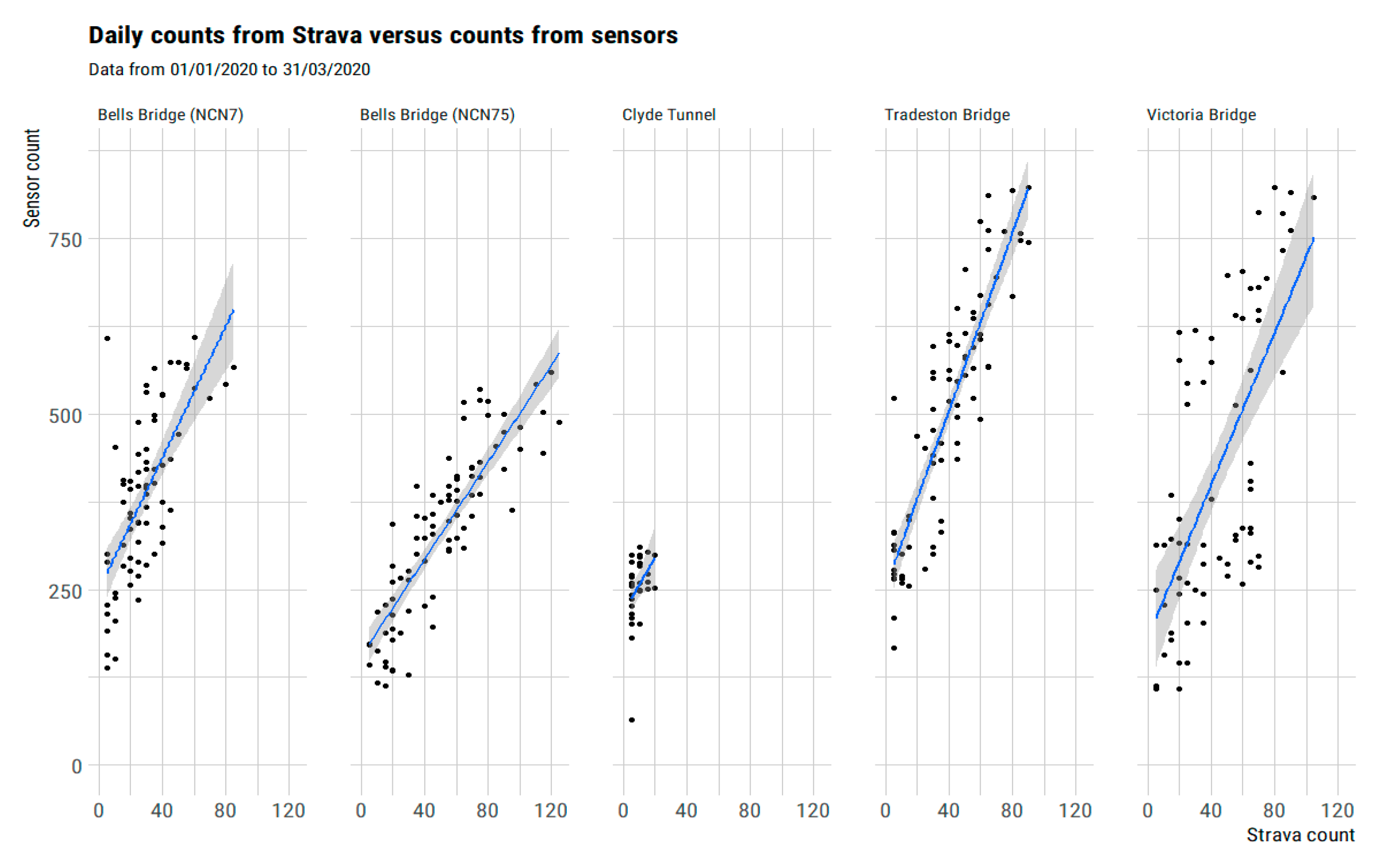
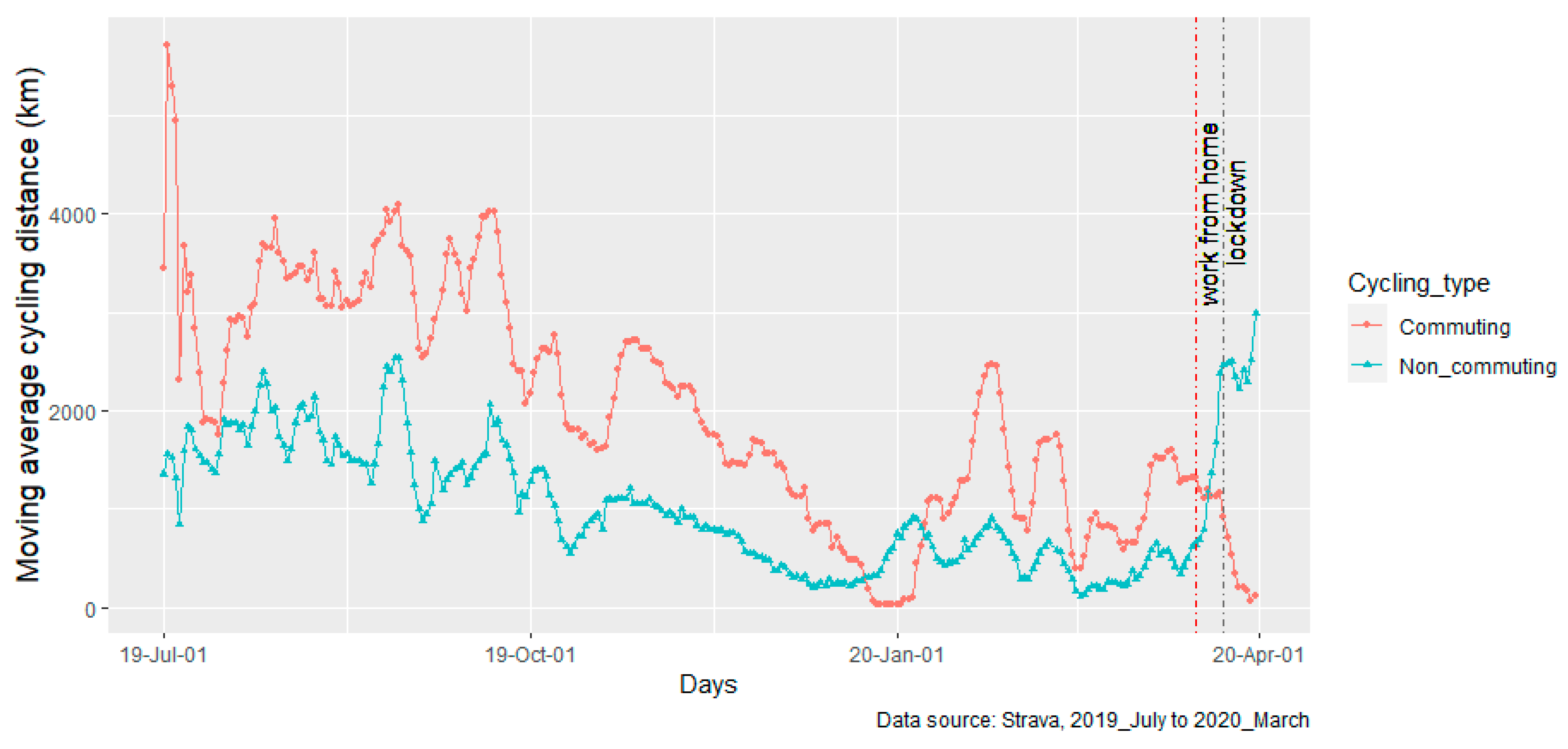
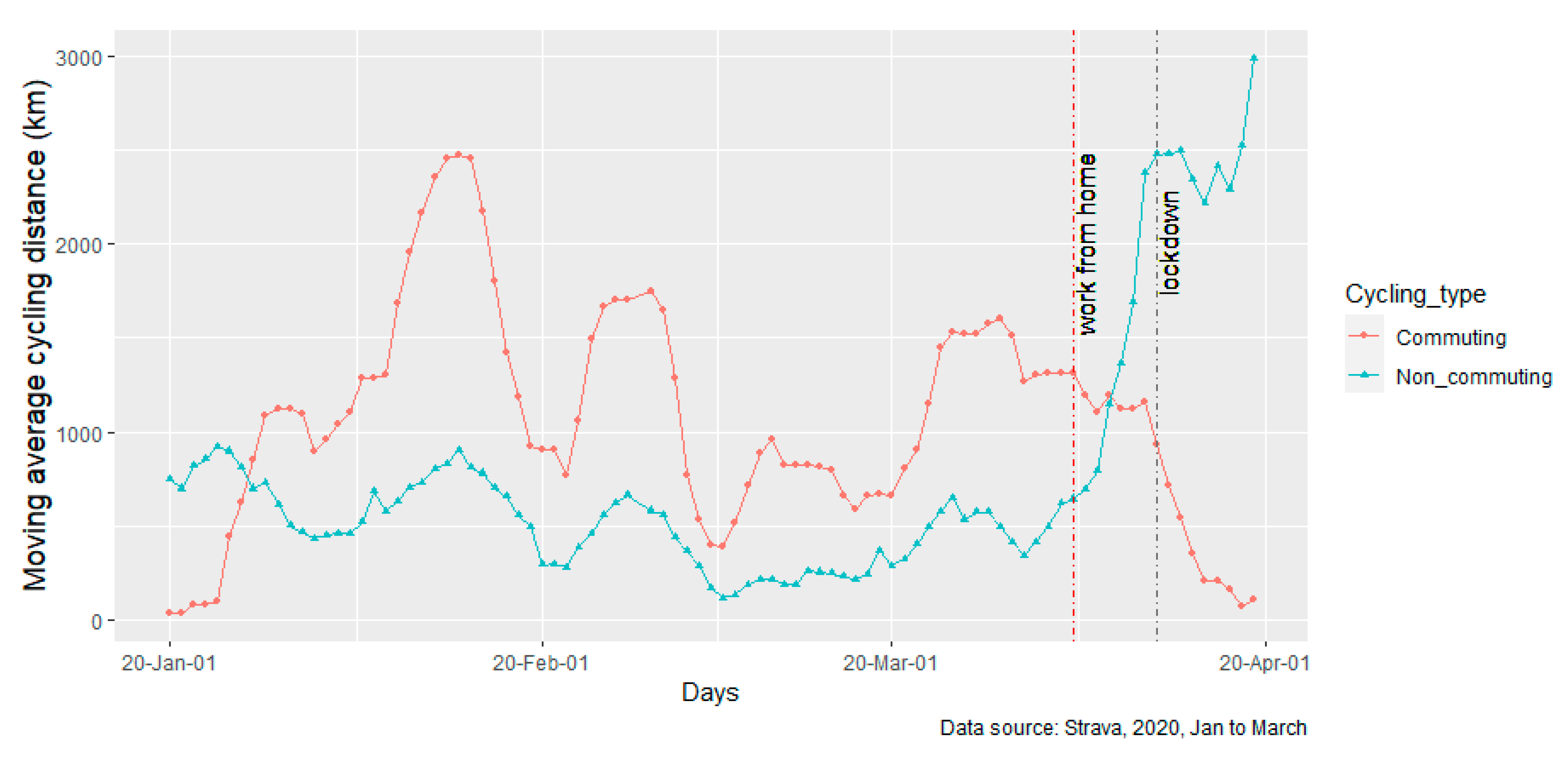
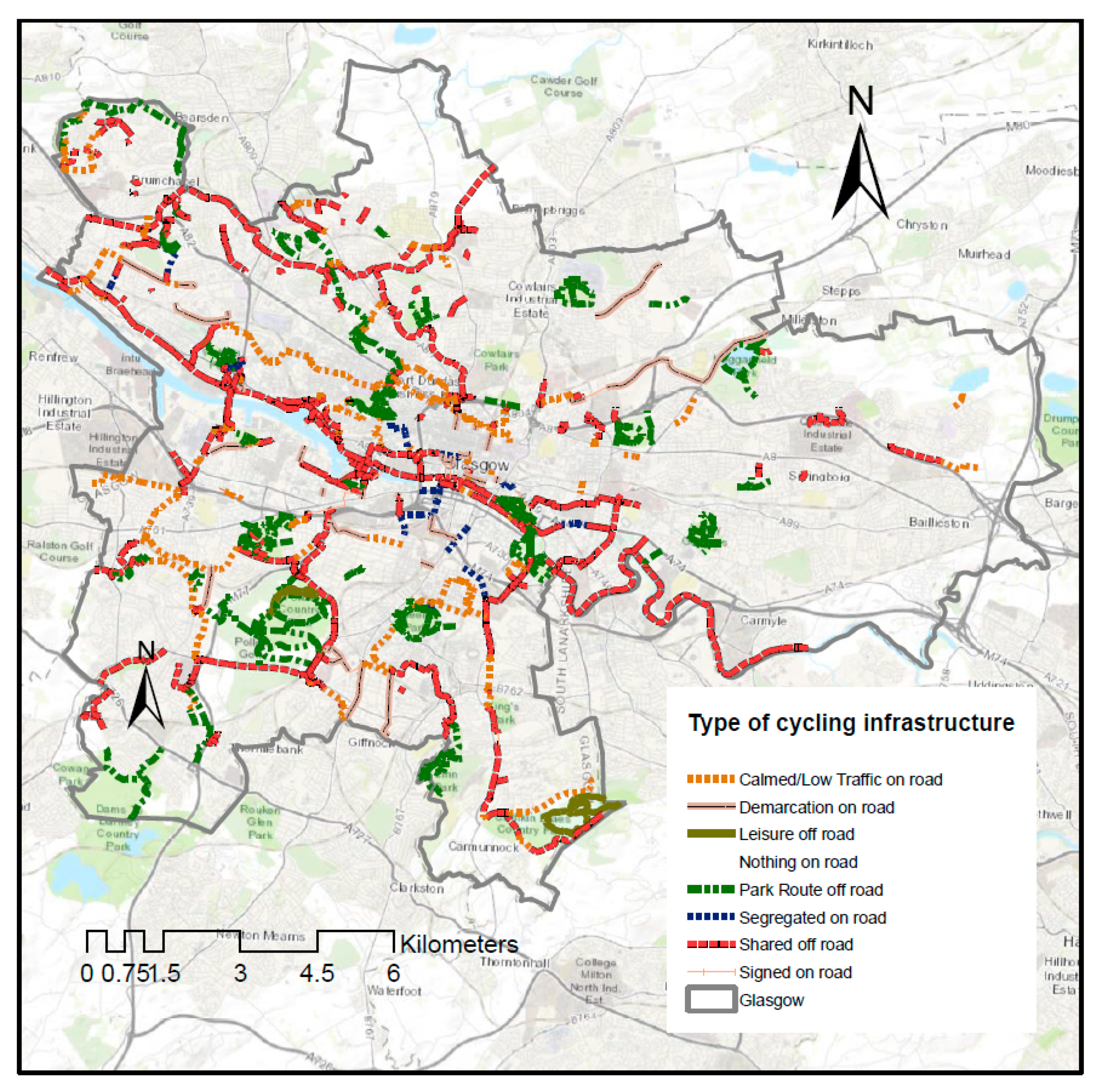
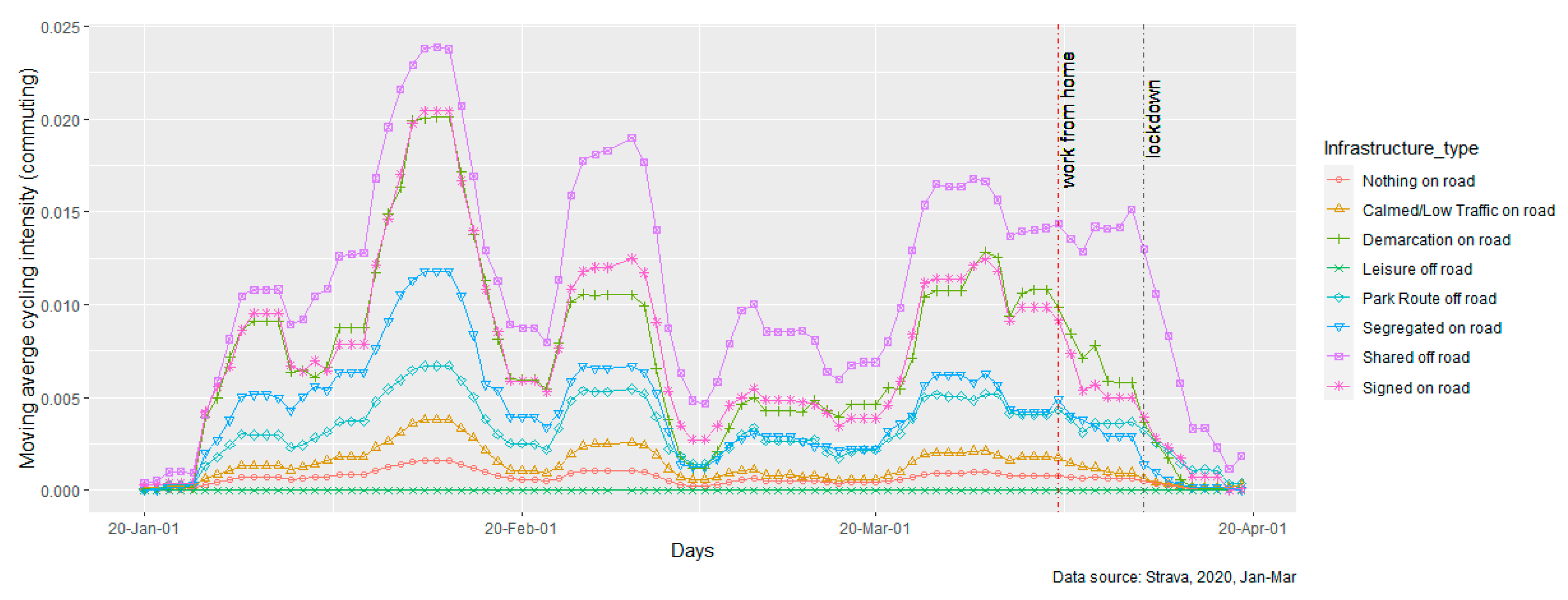
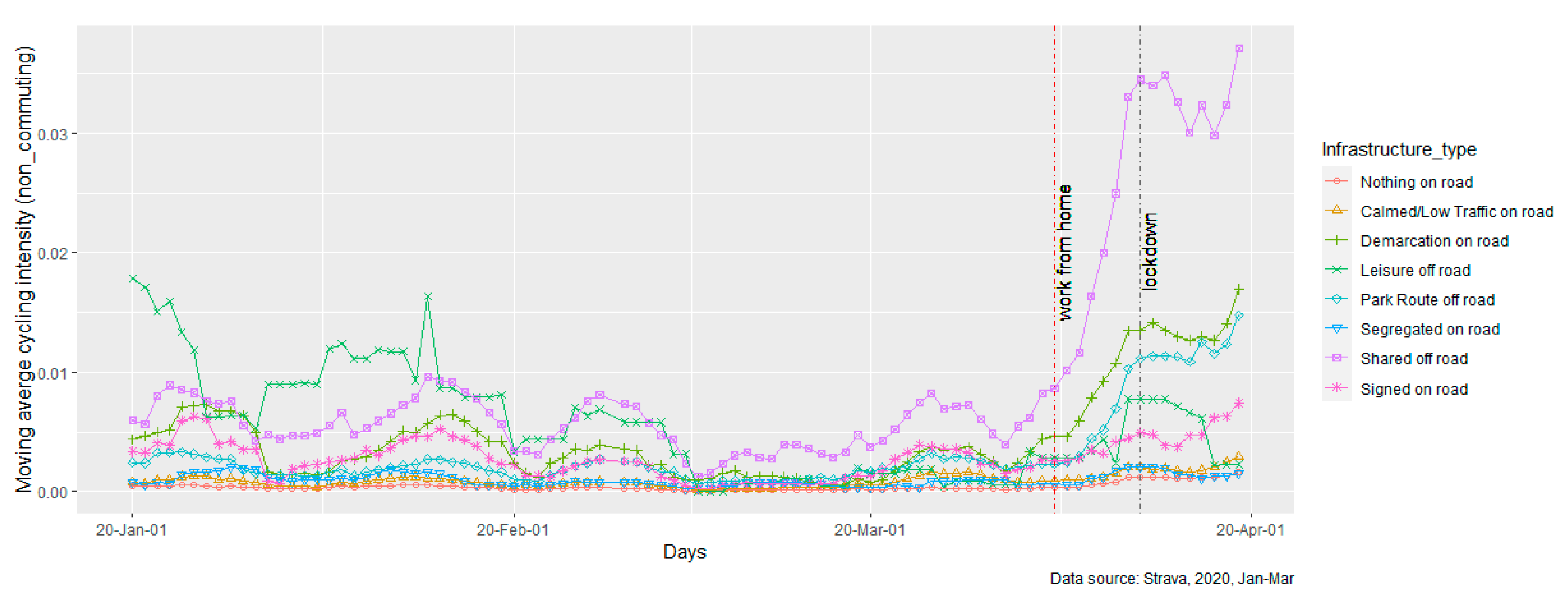
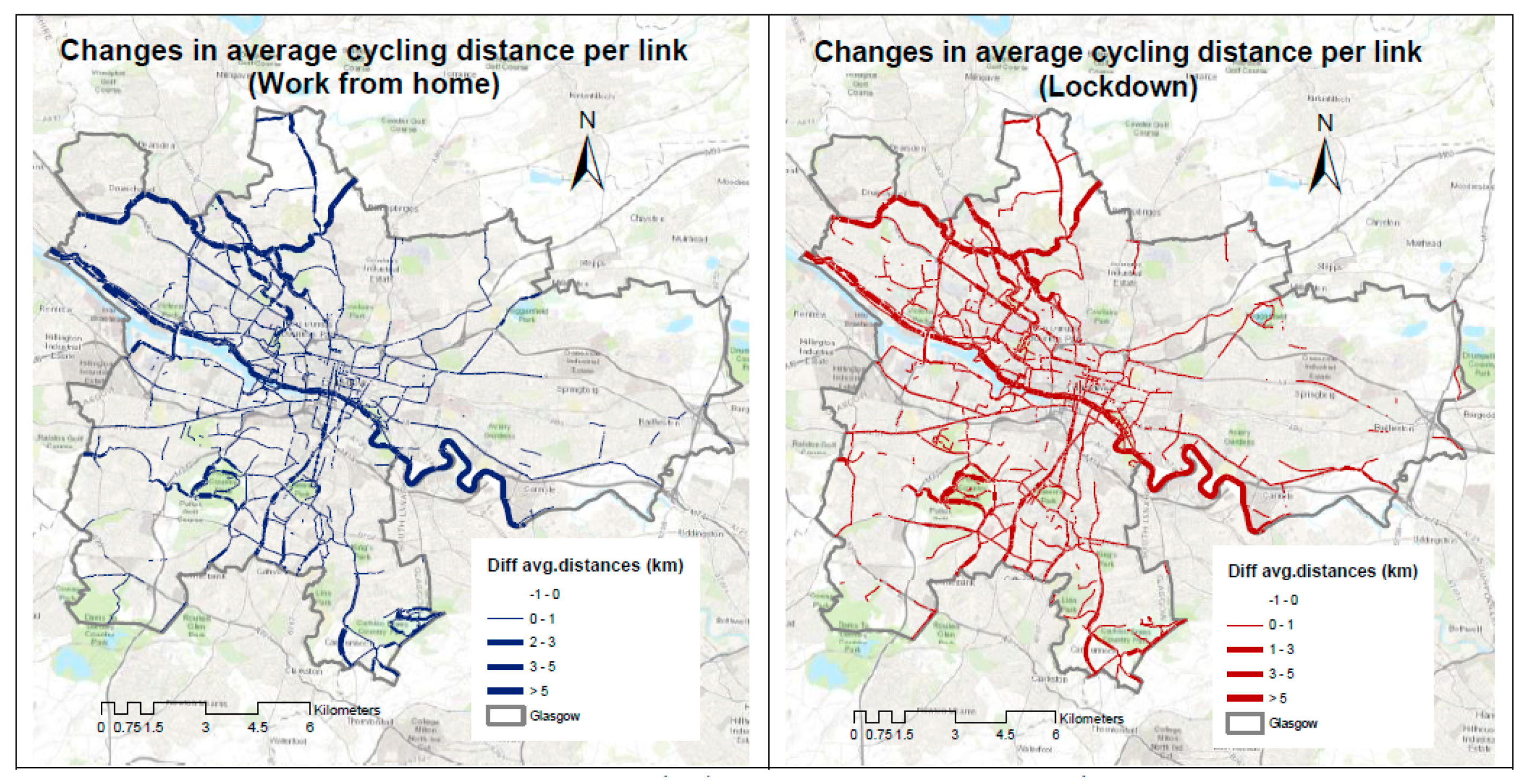
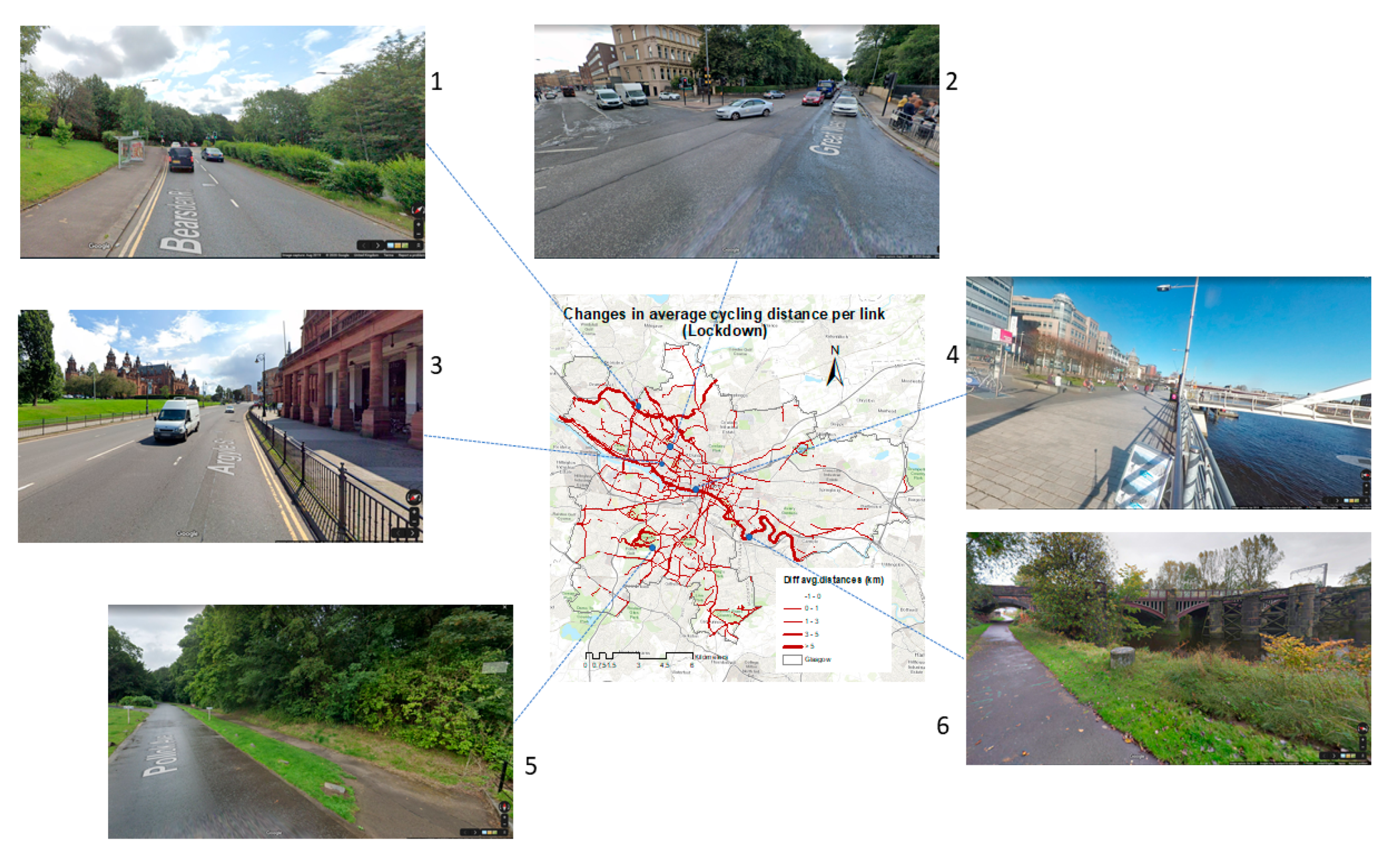
| Nothing | Calmed/Low | Demarcation | Leisure | Park | Segregated | Shared off | Signed | |
|---|---|---|---|---|---|---|---|---|
| Estimate | Estimate | Estimate | Estimate | Estimate | Estimate | Estimate | Estimate | |
| Constant | 0.022 *** | 0.019 *** | 0.076 *** | 0.097 *** | 0.031 *** | 0.01 | 0.065 *** | 0.040 *** |
| Government interventions | ||||||||
| Work from home | 0.012 *** | 0.012 *** | 0.051 *** | 0.03 | 0.043 *** | 0.01 | 0.078 *** | 0.01 |
| Lockdown | 0.014 *** | 0.010 ** | 0.051 *** | −0.01 | 0.052 *** | −0.01 | 0.071 *** | 0.01 |
| Day of week (ref:Sunday) | ||||||||
| Monday | −0.012 *** | 0.00 | −0.037 *** | −0.081 *** | −0.019 *** | 0.01 | −0.033 *** | −0.015 ** |
| Tuesday | −0.008 *** | 0.006 ** | −0.034 *** | −0.074 *** | −0.01 | 0.010 ** | −0.019 *** | −0.01 |
| Wednesday | −0.011 *** | 0.00 | −0.036 *** | −0.066 *** | −0.015 *** | 0.01 | −0.033 *** | −0.013 * |
| Thursday | −0.009 *** | 0.00 | −0.031 *** | −0.062 *** | −0.009 ** | 0.016 *** | −0.025 *** | −0.014 * |
| Friday | −0.012 *** | 0.00 | −0.043 *** | −0.075 *** | −0.01 | 0.00 | −0.017 ** | −0.023 *** |
| Saturday | −0.005 *** | 0.00 | −0.019 *** | −0.02 | 0.00 | 0.00 | 0.01 | −0.026 *** |
| Weather conditions | ||||||||
| Max temperature | 0.001 *** | 0.001 *** | 0.004 *** | 0.004 *** | 0.002 *** | 0.002 *** | 0.004 *** | 0.003 *** |
| Precipitation | −0.001 *** | −0.001 *** | −0.002 *** | −0.001 *** | −0.001 *** | −0.001 *** | −0.002 *** | −0.001 *** |
| Mean wind | −0.001 *** | −0.001 ** | −0.002 ** | 0.00 | −0.002 ** | 0.00 | −0.004 *** | −0.002 * |
| Daylight hours | 0.00 | 0.00 | 0.00 | 0.00 | 0.002 ** | 0.001 * | 0.003 *** | 0.00 |
| Sample size | 246 | 246 | 246 | 246 | 246 | 246 | 246 | 246 |
| Goodness-of-fit | ||||||||
| 0.72 | 0.45 | 0.64 | 0.34 | 0.65 | 0.50 | 0.72 | 0.40 | |
| Adjusted | 0.71 | 0.43 | 0.62 | 0.30 | 0.64 | 0.47 | 0.71 | 0.37 |
Publisher’s Note: MDPI stays neutral with regard to jurisdictional claims in published maps and institutional affiliations. |
© 2020 by the authors. Licensee MDPI, Basel, Switzerland. This article is an open access article distributed under the terms and conditions of the Creative Commons Attribution (CC BY) license (http://creativecommons.org/licenses/by/4.0/).
Share and Cite
Hong, J.; McArthur, D.; Raturi, V. Did Safe Cycling Infrastructure Still Matter During a COVID-19 Lockdown? Sustainability 2020, 12, 8672. https://doi.org/10.3390/su12208672
Hong J, McArthur D, Raturi V. Did Safe Cycling Infrastructure Still Matter During a COVID-19 Lockdown? Sustainability. 2020; 12(20):8672. https://doi.org/10.3390/su12208672
Chicago/Turabian StyleHong, Jinhyun, David McArthur, and Varun Raturi. 2020. "Did Safe Cycling Infrastructure Still Matter During a COVID-19 Lockdown?" Sustainability 12, no. 20: 8672. https://doi.org/10.3390/su12208672
APA StyleHong, J., McArthur, D., & Raturi, V. (2020). Did Safe Cycling Infrastructure Still Matter During a COVID-19 Lockdown? Sustainability, 12(20), 8672. https://doi.org/10.3390/su12208672







